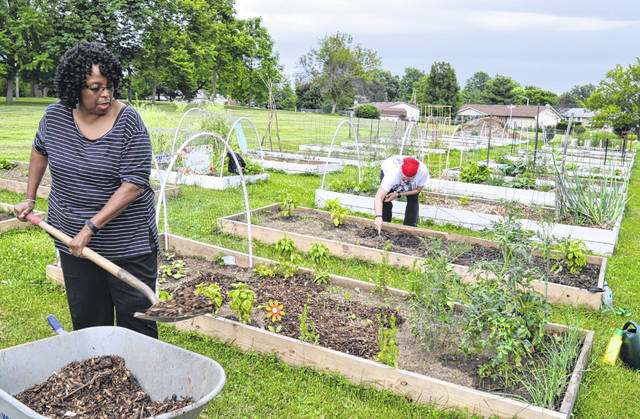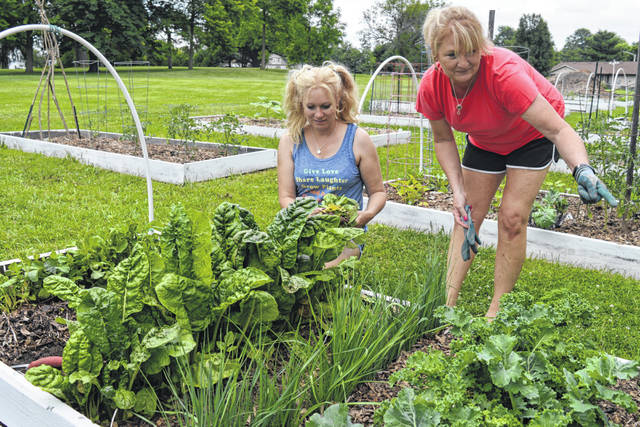

WILMINGTON — Created in response to the DHL pullout and Great Recession, a community gardens initiative in its 10th anniversary year is alive and productive this summer with 28 garden beds.
Though the local economic situation has changed since 2009, some of the basic goals of the original Grow Food, Grow Hope community gardens project have not changed. An aim to promote interest in small plot and backyard gardening by providing free gardening tools, seeds, seedlings and knowledgeable guidance is still there at the site on Wilmington College land off Quaker Way.
The community gardens project also has kept its objective of improving access of all community members to nutritious food by donating excess produce to Sugartree Ministries in Wilmington.
First-year Garden Manager Cassi DeHart is a non-traditional WC student majoring in agriculture. She has been an organic produce farmer, and has a herbalist and horticulture background.
This year has seen Lowe’s donate material for eight new garden boxes that subsequently were built. Local Master Gardeners have participated with classes for youth on probation through Juvenile Court. And before going home for the summer, WC students volunteered time toward the gardens project.
Some of the gardeners this year are beginners while others have taken part in the community gardens before, said DeHart.
Along with the participants’ garden plots, there is a garden bed DeHart uses to teach about herbs which can be used for food, brewing tea, medicinal purposes, and, when dried, craft-making.
When it comes to growing food DeHart loves sustainability. And she’s a booster for perennial food such as asparagus and some types of onions.
She is encouraging the community gardens participants to apply wood chips around the plants in their garden beds, where a layer of “wood chips” translates to “weed-free.” A wood-chip mulch will also decompose and add nutrients to the soil.
DeHart is enthusiastic about growing pole beans which allows the gardener to maximize planting space. In contrast to the bush varieties of beans, pole beans involve some training onto a pole, stake or trellis.
“It’s fun to try a new thing,” she said.
Community gardener Terri Gross was on-site when DeHart spoke about pole beans, and Gross added that the pole beans she ate were delicious.
In addition to vegetables fresh from her two garden beds, Gross enjoys the fellowship with the other community gardeners. Peas, kale, leeks, Swiss chard, onions, summer squash and potatoes inhabit Gross’ garden plot.
Dr. Nina Talley, WC director of career services who has a community gardens bed, describes herself as “very much a novice” in gardening. As a young girl she helped her grandmother grow tomatoes, but that was it until this season.
Talley said DeHart has assisted her in making sure she has everything she needs for a garden bed. The bed contains tomatoes, peppers, basil, cilantro, onions, cabbage and some cucumbers and zucchini.
Gardening complements her office job. “It’s a good way to get some balance,” Talley said about gardening.
During the first year of “Grow Food, Grow Hope”, there were local master gardeners involved, as were WC ag professor Monte Anderson, and nine AmeriCorps VISTA (Volunteers In Service To America) participants.
Federal stimulus dollars were provided to support the VISTA young people, who performed other local work, much of it related to food security in a place slammed hard with joblessness.
The original idea for the Grow Food, Grow Hope community gardens hearkened back to the Victory Gardens of the World War II homefront. While the nation endured shortages and rationing in support of the war effort, reportedly 41 percent of all the fruit and vegetables consumed in the United States in 1943 was grown in more than 20 million small gardens.
Grow Food, Grow Hope was a meaningful outreach to the local community by Wilmington College, and is a notable event in the history of town/gown relations between the city and the college.
Reach Gary Huffenberger at 937-556-5768.



